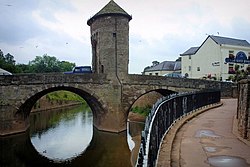Monmouth
| Monmouth | |
| Monmouthshire | |
|---|---|
 The Monnow Bridge and Gatehouse Pub | |
| Location | |
| Grid reference: | SO505125 |
| Location: | 51°48’36"N, 2°43’12"W |
| Data | |
| Population: | 8,547 (2001) |
| Post town: | Monmouth |
| Postcode: | NP25 |
| Dialling code: | 01600 |
| Local Government | |
| Council: | Monmouthshire |
Monmouth is a the county town of Monmouthshire. It is situated close to the border with Herefordshire, where the River Monnow meets the River Wye with bridges over both. The mediæval 13th century stone gated bridge over the Monnow is unique in Britain being the only preserved bridge of its design remaining.
History
Monmouth as an organised settlement dates back to the times of Roman Britain. The Romans called it Blestium, and it was part of a network of Roman forts covering the region, linked via Roman roads to Abergavenny (Gobannium), Usk (Burrium), later Isca Augusta at Caerleon and Glevum at Gloucester. Archaeologists and historians have found items of Roman pottery and Roman currency and coinage that date from that period.
Middle Ages
The town appears in the Domesday Book, and for the 11th century and 12th century the town and surrounding areas were ruled by Norman French lords after the Norman conquest by William the Conqueror in 1066. During this time, Monmouth Castle was built, in 1067 under William Fitz-Osbern of Breteuil, Normandy, a significant castle builder, holding commanding views over the surrounding area from a sound defensive site. Initially it would have been a motte and bailey castle, rebuilt in stone and later refortified and developed over time.
The Battle of Monmouth was fought in 1233 between the rebel forces of Richard Marshal, 3rd Earl of Pembroke, and a royalist force under John of Monmouth. The rebels carried the day and St Thomas' Church and Monnow Bridge were torched in the battle, which took place beside the River Monnow on Castle Field, land today known as Vauxhall Fields. The battle was immortalised by an illustration by 13th century historian Matthew Paris, which shows Richard Marshal unhorsing Baldwin of Guisnes. The original is owned by Corpus Christi College, Cambridge.
The castle came into the possession of the House of Lancaster through the marriage of John of Gaunt to Blanche, a Monmouth based heiress. John of Gaunt strengthened the castle, adding the Great Hall.
In 1387, Henry V was born in Monmouth Castle in the Queen's Chamber within the gatehouse. The castle became a favourite residence of the House of Lancaster. Henry would win the Battle of Agincourt in 1415. Many parts of Monmouth, including the town's main square, are named after this battle.
Post-mediæval times

In 1605, James I granted Monmouth a town charter by letters patent. The granting of the charter included the charge that the town "at all perpetual future times ... be and remain a town and borough of Peace and Quiet, to the example and terror of the wicked and reward of the good".[1]
The layout of the town as depicted in Speed's map of 1610 would be easily recognisable to present-day inhabitants, with the layout of the main axis from the castle via the main street, Monnow Street, to the bridge clearly visible. Monnow Street is a typical market street, in being wide in the middle (for those selling) and narrow at each end (to help prevent the livestock escaping).
In 1840 at Monmouth's Shire Hall, Chartist protesters John Frost, Zephaniah Williams and William Jones became the last men in Britain to be sentenced to be hanged, drawn and quartered after being found guilty of treason following riots in Newport that led to 20 deaths. The sentences were later commuted to transportation to Australia.[2]
References
- ↑ "Monmouth Town Council". http://www.monmouth.gov.uk/pages/monmouth.htm. Retrieved 2006-02-01.
- ↑ "Chartists in Monmouth". http://www.forest-and-wye-today.co.uk/tn/news.cfm?id=42387&searchword=chartists. Retrieved 2009-11-20..